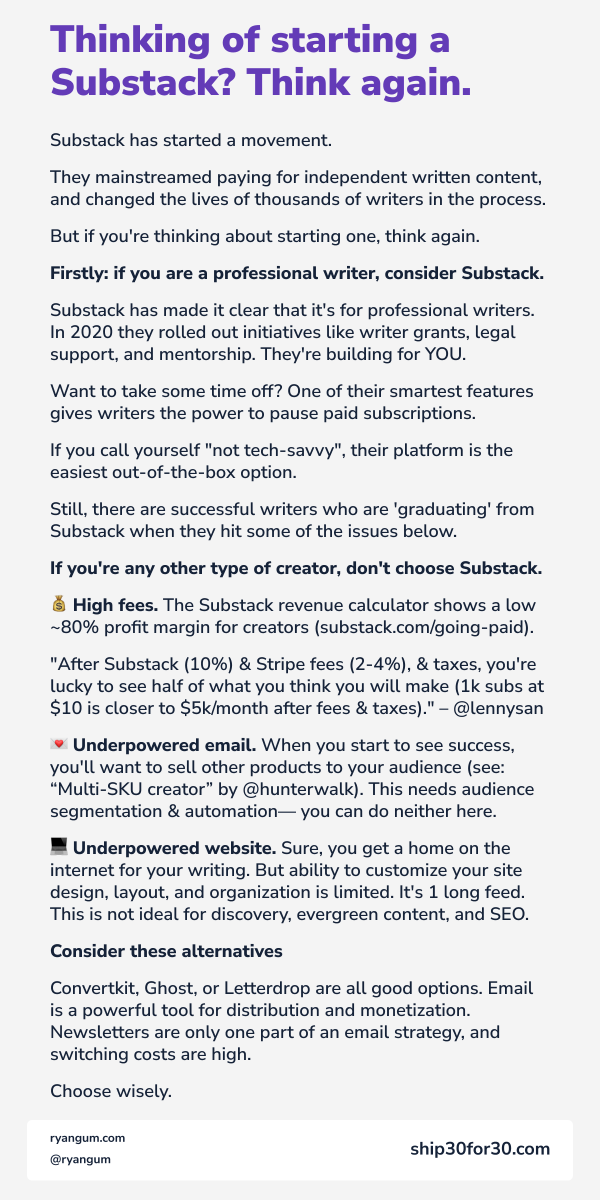
What are the jobs-to-be-done for creators?
1. Help me grow my business
2. Help me run my business
3. Help me save time
Creator platforms can leverage these jobs to shape their product, marketing, and pricing & packaging strategy 👇
1. Help me grow my business
2. Help me run my business
3. Help me save time
Creator platforms can leverage these jobs to shape their product, marketing, and pricing & packaging strategy 👇

What are the types of creators? What are their JTBD?
JTBD is an approach to developing products based on the customer’s specific goal, or “job”, and how they decide to “hire” a product to complete the job.
JTBD is an approach to developing products based on the customer’s specific goal, or “job”, and how they decide to “hire” a product to complete the job.
By understanding creators' JTBD, companies can build products that solve real problems.
At @teachable, we've interviewed and surveyed thousands of creators and identified their JTBD. Lets split them into 2 types:
1. Aspirationals
2. Professionals
At @teachable, we've interviewed and surveyed thousands of creators and identified their JTBD. Lets split them into 2 types:
1. Aspirationals
2. Professionals
🙇♂️ Aspirational creators
• Work a full-time job but hope to earn a living outside of it.
• Have a small audience and no revenue.
• Need help figuring out their niche, building a publishing habit, and building an audience.
This is the largest segment of creators.
• Work a full-time job but hope to earn a living outside of it.
• Have a small audience and no revenue.
• Need help figuring out their niche, building a publishing habit, and building an audience.
This is the largest segment of creators.
💻 Professional creators
• Self-employed business owners.
• Might have hired help.
• Large % of their income comes from their creator work.
• Working on or thinking about their business every day.
• Have multiple revenue streams.
• Self-employed business owners.
• Might have hired help.
• Large % of their income comes from their creator work.
• Working on or thinking about their business every day.
• Have multiple revenue streams.
The JTBD for Professional creators
Help me grow my business
• Continue growing my audience
• Maximize my audience monetization
• Execute a strategy and analyze results
Help me grow my business
• Continue growing my audience
• Maximize my audience monetization
• Execute a strategy and analyze results
Help me run my business
• Engage my audience, provide customer support
• Handle payments, payouts, refunds, taxes
• Consolidate my business backend
• Engage my audience, provide customer support
• Handle payments, payouts, refunds, taxes
• Consolidate my business backend
Help me save time
• Delegate work to freelancers / contractors / hire
• Build systems and automate repetitive tasks
• Focus on the highest ROI activities
• Delegate work to freelancers / contractors / hire
• Build systems and automate repetitive tasks
• Focus on the highest ROI activities
What can creator platforms can takeaway from this?
As you grow, you'll likely attract more aspirationals. While they might be the largest segment, they're also the least profitable.
Building for them is tempting, but they are a distraction.
As you grow, you'll likely attract more aspirationals. While they might be the largest segment, they're also the least profitable.
Building for them is tempting, but they are a distraction.
The majority of aspirationals aren't willing or able to pay as much, and even if they do, they aren't as likely to find success — so they'll churn. This might sound like tough love, but it's the reality.
Aspirationals aren't comfortable spending $$$/m on your product.
Aspirationals aren't comfortable spending $$$/m on your product.
Focus on those who depend on their business for income.
Professionals are comfortable spending $$$/m on your product if you help them grow their business. It's an investment.
The more successful they become, the more they are willing to trade money for time.
Professionals are comfortable spending $$$/m on your product if you help them grow their business. It's an investment.
The more successful they become, the more they are willing to trade money for time.
Adapt your product, marketing, and pricing & packaging strategy accordingly.
• • •
Missing some Tweet in this thread? You can try to
force a refresh



